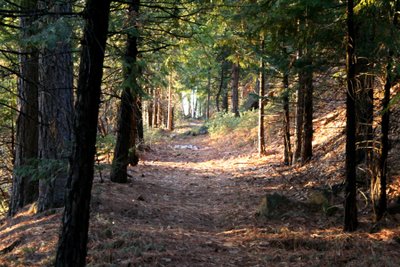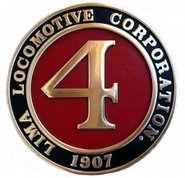Nine crewmen gathered at the engine house to continue work on two locomotives. The railway is currently in possession of three engines, as follows:
- Diamond & Caldor No. 4, 2-truck Shay (CN 1896), built in 1907
- Arnold Z, the Plymouth, switcher from Glenn Bell's West Side & Cherry Valley Railroad (possibly the No. 11 according to John Barnhill)
- Michigan-California Lumber Co. No. 6, a 0-4-0T Porter (CN 2044), built in 1899
A fourth, the Diamond & Caldor Tally Ho No. 10 railbus, is owned by the El Dorado County Historical Museum. EDWRF Vice-President Keith Berry announced Saturday that the El Dorado County Museum Commission approved funding to restore the railbus to its original Diamond & Caldor configuration.
The commission released the initial $1,000 to purchase metal to restore the steel cab and frame. Future funds will be available to rebuild the Waukesha engine and redesign a new brake system. (I mistakenly reported the engine as a Waukesha. See this post and this one.)
The Plymouth crew of Garrett, Ken and Scott continued work on Arnold. They were able to move both wheel sets to spot where we can load them on one of the pick up trucks. Garrett has working with a few Sacramento machine shops to turn the wheels. They closed the day chipping and priming one side of the locomotive's large steel frame.
Welder Dale continued building another set of saw horses. This set will stand 4 feet above ground level. We plan to use this set to access the high points on the No. 4.
Dale also built a second chop saw stand. Since the railway has a large stock of old boiler flues, we plan to build several saw horse sets for our supporters. If interested, please contact me at my email address (Steve -at- SeabeeCook.com). President Eric Stohl has not set a donation price yet.
Sam's "Rube Goldberg" valve shaper is nearing completion after 15 months of trail and error design and construction. Sam and Bill spent Saturday installing the pneumatic controls to the shaper. We expect a test run soon.
Housekeeping work also continued. Keith vacuumed about 10 pounds of bead material from the bead blaster. He then poured a fresh 50-pound bag into the machine. His next project is to clean the brake parts to the flat car.
I have more news, including the donation of 1,500-feet of high-grade rail to the foundation. I'll post more news through the week.

 About noon, I commented to EDWRF President Eric Stohl that the crew was sticking around for the meal. Eric (in white coveralls) didn't seem that amused. "Yea, but I loosing productivity here!" I think the crew ignored him. Nine volunteers (including the cook) scarfed a large pot of
About noon, I commented to EDWRF President Eric Stohl that the crew was sticking around for the meal. Eric (in white coveralls) didn't seem that amused. "Yea, but I loosing productivity here!" I think the crew ignored him. Nine volunteers (including the cook) scarfed a large pot of 
 As much as possible, the El
As much as possible, the El  Keith and Dale have already began to make cut marks for Dale's welding torch. The remains of
Keith and Dale have already began to make cut marks for Dale's welding torch. The remains of  The Steely Fork line heads to the west as it climbs out of the Steely Fork canyon. This cut is found a hundred feet west of the ruins of the river trestle. The Steely Fork trestle crossed the river just west of the confluence of the North and South Steely creeks.
The Steely Fork line heads to the west as it climbs out of the Steely Fork canyon. This cut is found a hundred feet west of the ruins of the river trestle. The Steely Fork trestle crossed the river just west of the confluence of the North and South Steely creeks. One of the few trestle bents that's remains upright. All four trestles collapsed years ago. Today the heavy timbers are slowly rotting.
One of the few trestle bents that's remains upright. All four trestles collapsed years ago. Today the heavy timbers are slowly rotting. The first trestle can be reached after a 10 minute hike from the Trestle Trail trail head. It's still possible to see some organization to the heavy bridge timbers on the ground. I was able to count a dozen or more bents at this trestle site. Most of the timbers (10x10 or larger) are in very good condition considering it's been 54 years since abandonment.
The first trestle can be reached after a 10 minute hike from the Trestle Trail trail head. It's still possible to see some organization to the heavy bridge timbers on the ground. I was able to count a dozen or more bents at this trestle site. Most of the timbers (10x10 or larger) are in very good condition considering it's been 54 years since abandonment. Bridge timbers are lined up on the ground between the eastern and western landings. This picture looks to the east.
Bridge timbers are lined up on the ground between the eastern and western landings. This picture looks to the east. The four or five crewmen that have come to the engine house each Saturday work on an assortment of odd projects. Little work is being done on the Diamond & Caldor No. 4 or on Arnold at this time.
The four or five crewmen that have come to the engine house each Saturday work on an assortment of odd projects. Little work is being done on the Diamond & Caldor No. 4 or on Arnold at this time.
 To access Trestle Trail, take Capps Crossing Road from Grizzly Flat to Forest Road 9N86. Continue east along the road for a half mile. Turn right onto Road 9N86A. An abandoned vehicle about three-tenths of a mile down the road partially blocks the road.
To access Trestle Trail, take Capps Crossing Road from Grizzly Flat to Forest Road 9N86. Continue east along the road for a half mile. Turn right onto Road 9N86A. An abandoned vehicle about three-tenths of a mile down the road partially blocks the road. After you drive another half mile (or so -- I didn't clock it), you'll see this sign to the left up on the old railroad grade. Park your car in the wide spot and hike the trail.
After you drive another half mile (or so -- I didn't clock it), you'll see this sign to the left up on the old railroad grade. Park your car in the wide spot and hike the trail.

